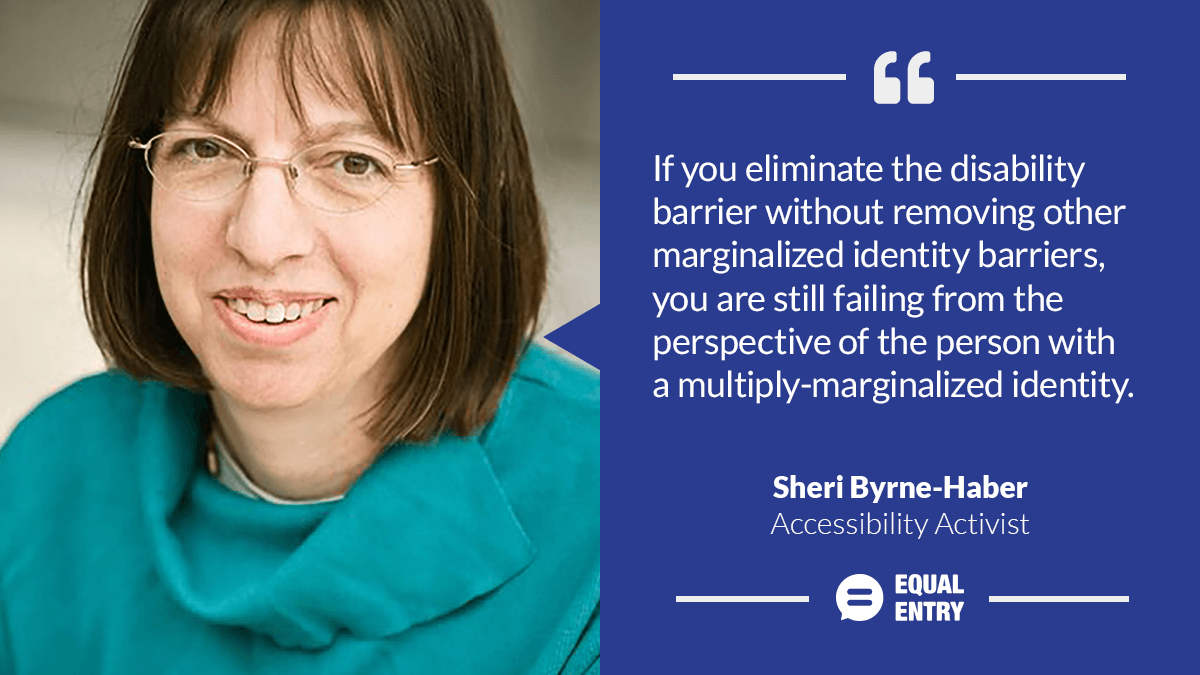Summary

Sheri Byrne-Haber is a prominent global subject matter expert in the fields of disability and accessibility in business and educational settings. She is best known for launching digital accessibility programs at multiple Fortune 200 companies, including McDonald’s, Albertsons, and VMware, as well as consulting on government accessibility.
Sheri’s award-winning Medium blog summarizes legal cases and issues facing people implementing accessibility programs, with over 300,000 readers since its launch.
Sheri is a frequent panelist and speaker at accessibility-related conferences and an active member of several accessibility committees and non-profits, helping drive and communicate the evolution of accessibility standards. She’s the author of “Giving a Damn about Accessibility,” which is a free download.
How did you get your start in accessibility?
As of 2012, I had spent eight years as an attorney who had been fighting for the rights of people who were deaf. My cases were primarily against health insurers and school districts. I won a significant case against one of the largest health insurers in the country, and all the other health insurers began to fold.
I had gotten into advocating for the deaf because my daughter is deaf. I felt very fortunate that I was a lawyer, and English was my native language. Otherwise, she could have had a very different outcome.
Once my caseload began to dwindle, I began to look at what I could do with my degrees in computer science, law, and business. Accessibility seemed to be the best career choice that combined my educational background with my passion for creating equitable environments for people with disabilities.
I had spent eight years as an attorney who had been fighting for the rights of people who were deaf. My cases were primarily against health insurers and school districts. I won a significant case against one of the largest health insurers in the country, and all the other health insurers began to fold.
What are your most popular articles on Medium? What are your thoughts on why they resonated with so many?
My most popular articles fall into one of two categories:
- Articles that explain accessibility legal cases and their implications in English like this one on the Domino’s case or this one on the Eyebob’s case.
- Articles that provide designers with clear-cut instructions on what they need to do and not to do to create accessible designs like this article on designing in dark mode.
You have worked on kiosks and digital wayfinding accessibility. What was different about making sure they provide an accessible experience?
Kiosks and digital wayfinding are an interesting challenge because it combines both physical accessibility and digital accessibility in an environment with a lot of background noise where you can’t always access human support. In the beginning, we thought headphones and keyboard jacks would be sufficient and people with disabilities could bring your own assistive technology (BYOAT).
Then we discovered that you could buy a device on eBay for $50 that went into the keyboard jack port and could fry an $80,000 kiosk. After that option was eliminated, screen readers became the only option. Alternatively, equivalent accessible apps work well also.
How does your legal background help you in your accessibility work?
Every day I use my legal background. Some examples of that include:
- Interpreting or drafting new regulatory language.
- Helping people write contract clauses that include accessible deliverables.
- Assimilating vast amounts of information and synthesizing it.
- Writing clear blogs and summaries.
We hear you’re an archery pro. Can you tell us about that?
The Thanksgiving before the pandemic started, the design system and accessibility teams got together for an indoor archery event. I really loved archery when I was a kid, and I went out and bought a compound bow the following weekend.
I was terrible at first, I sometimes missed the target entirely, and only had enough upper body strength to do maybe 30 arrows at 20 lbs before I got tired and had to stop. I got a coach who knew a lot about kinesiology, and she helped me adapt my shot to work around my spinal curvature.
I have a range at my house and practice almost every day. Recently, I won the California State Seniors archery championship for my type of bow and age group. In my last competition, I shot 142 arrows at 43 lbs draw weight.

What is an accessibility barrier you would like to see solved?
I would like to see captions required for every single conferencing tool and turned on automatically without having to request it from the meeting owner. Associated with that, I would also like to see an open-source pronunciation dictionary where technical terms and non-English pronunciations can be added.
We don’t have a single screen reader or captioning system that I am aware of that provides real-time captions or announces indigenous languages. That is truly shameful. Humans are intersectional beings. If you eliminate the disability barrier without removing other marginalized identity barriers, you are still failing from the perspective of the person with a multiply-marginalized identity.